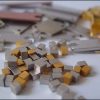
Aluminum bronze with wAl content of less than 7% has less developed dendrites in the as-cast structure than tin bronze. It is a single-phase α and has good plasticity. After hot working or cold working annealing, annealing twins appear in α solid solution grains. When the aluminum content wAl is 7% to 9.4%, the structure is α+δ at high temperature according to the phase diagram, and it should be α single-phase solid solution below 565°C. However, in actual production, the β→α transformation often cannot be completed and a small amount of β phase remains. The β phase is then decomposed into α+γ2 eutectoid, which obviously increases the strength and reduces the plasticity. When wAl>9.4%, the alloy phase transformation process is very complicated. When cooling slowly, a β→α+γ2 eutectoid transformation occurs at 565°C, resulting in an eutectoid (lamellae) with a morphology similar to pearlite in steel. The alloy embrittles when γ2 is coarse in the eutectoid. This phenomenon is called “spontaneous annealing”. When the cooling rate is increased, the eutectoid decomposition is suppressed, and the bainite and martensite transformations occur in sequence according to the reached residence temperature. The pervious transformation α+γ2→α2 near 363℃ reacts very slowly, which is not in actual production.
The influence of different chemical elements on the structural characteristics of aluminum bronze
- 1. Iron, manganese and nickel are the main added elements in aluminum bronze. Therefore, there are Cu-Al-Fe, Cu-Al-Mn, Cu-Al-Fe-Mn, Cu-AlFe-Ni and Cu-Al-Fe-Mn-Ni systems for complex aluminum bronze.
- 2. Iron is added to the Cu-Al alloy to inhibit the decomposition of β→α+γ2 and prevent embrittlement caused by spontaneous annealing. In addition, adding a certain amount of iron can form fine FeAl3 particles, which can serve as the non-spontaneous nuclei of the α phase to refine the α grains in the as-cast structure.
- 3. The solubility of manganese in Cu-Al alloy is relatively large, which can cause solid solution strengthening. More importantly, it can also suppress spontaneous annealing. The addition of manganese has no obvious effect on the structural characteristics of aluminum bronze.
- 4. The main function of nickel is to improve the mechanical properties, thermal strength and corrosion resistance of the alloy. Nickel is mainly added to aluminum iron bronze, in addition to dissolving into solid solution (α and β), it can also form K phase. This phase is a Ni-Fe-Al compound with an ordered body-centered cubic lattice, and its structure is similar to NiAl and FeAl. The content and mutual ratio of aluminum, iron and nickel in the alloy, and the heat treatment conditions of the alloy all affect the precipitation morphology of the K phase and the properties of the alloy.
- 5. When the nickel content is greater than the iron content, the K phase will be lamellar, and when the nickel content is less than the iron content, the K phase will be precipitated as a block. Only when the contents of iron and nickel are roughly equal, the K phase is precipitated as fine grains, which is beneficial to the mechanical properties of the alloy.
- 6. Iron, manganese and nickel are the main added elements in aluminum bronze. Therefore, there are Cu-Al-Fe, Cu-Al-Mn, Cu-Al-Fe-Mn, Cu-AlFe-Ni and Cu-Al-Fe-Mn-Ni systems for complex aluminum bronze.
The structure of aluminum bronze is easy to identify. Generally, it can be corroded by reagents such as ferric chloride hydrochloric acid aqueous solution or ferric chloride hydrochloric acid alcohol solution. The α phase is white and bright, and the β phase (or eutectoid) is dark gray. The iron-containing phase is a bright gray particle, which is difficult to distinguish if it is very small. The K phase is also bright gray. The structure formed by the intersection of martensite has obvious needle-like characteristics.






